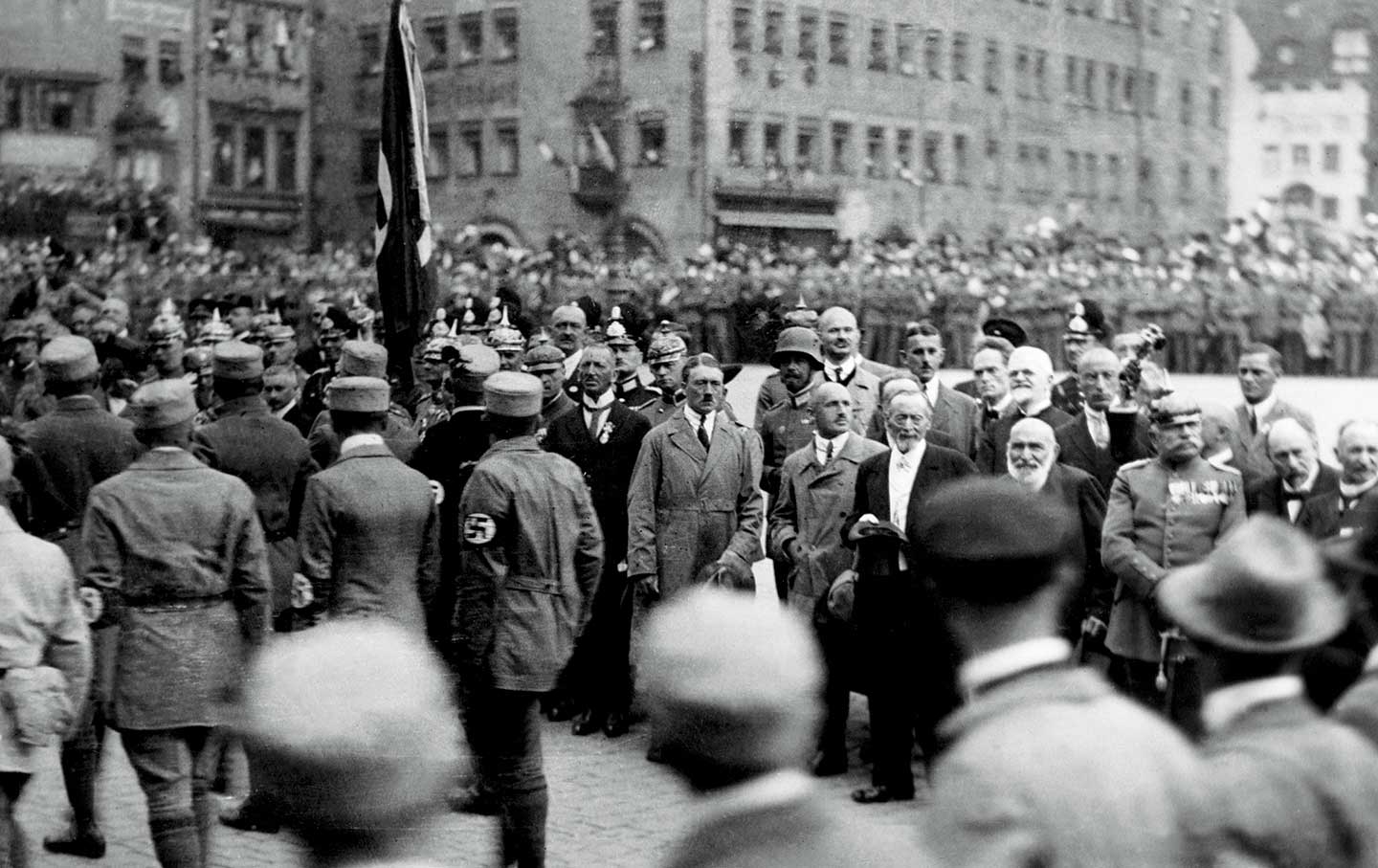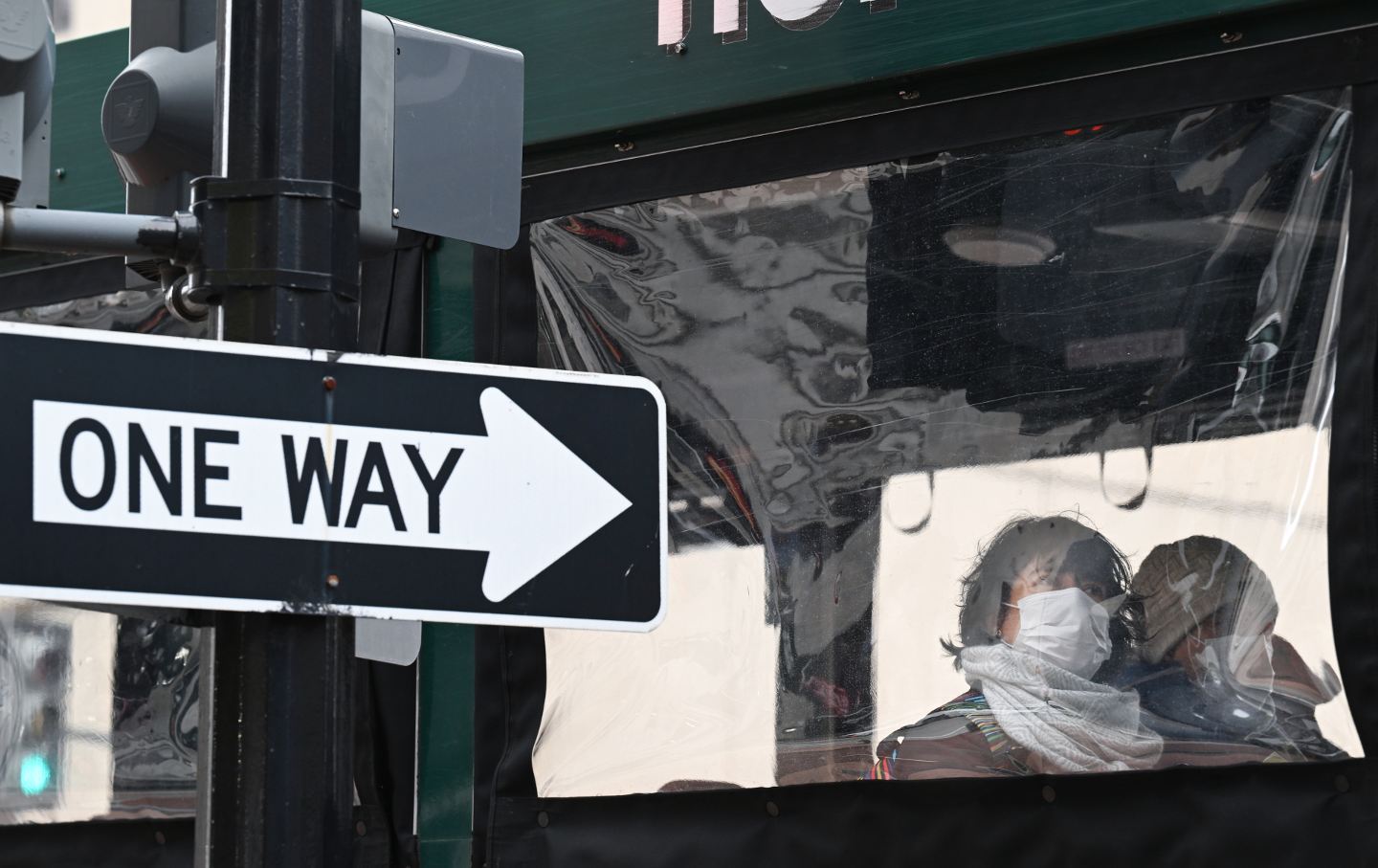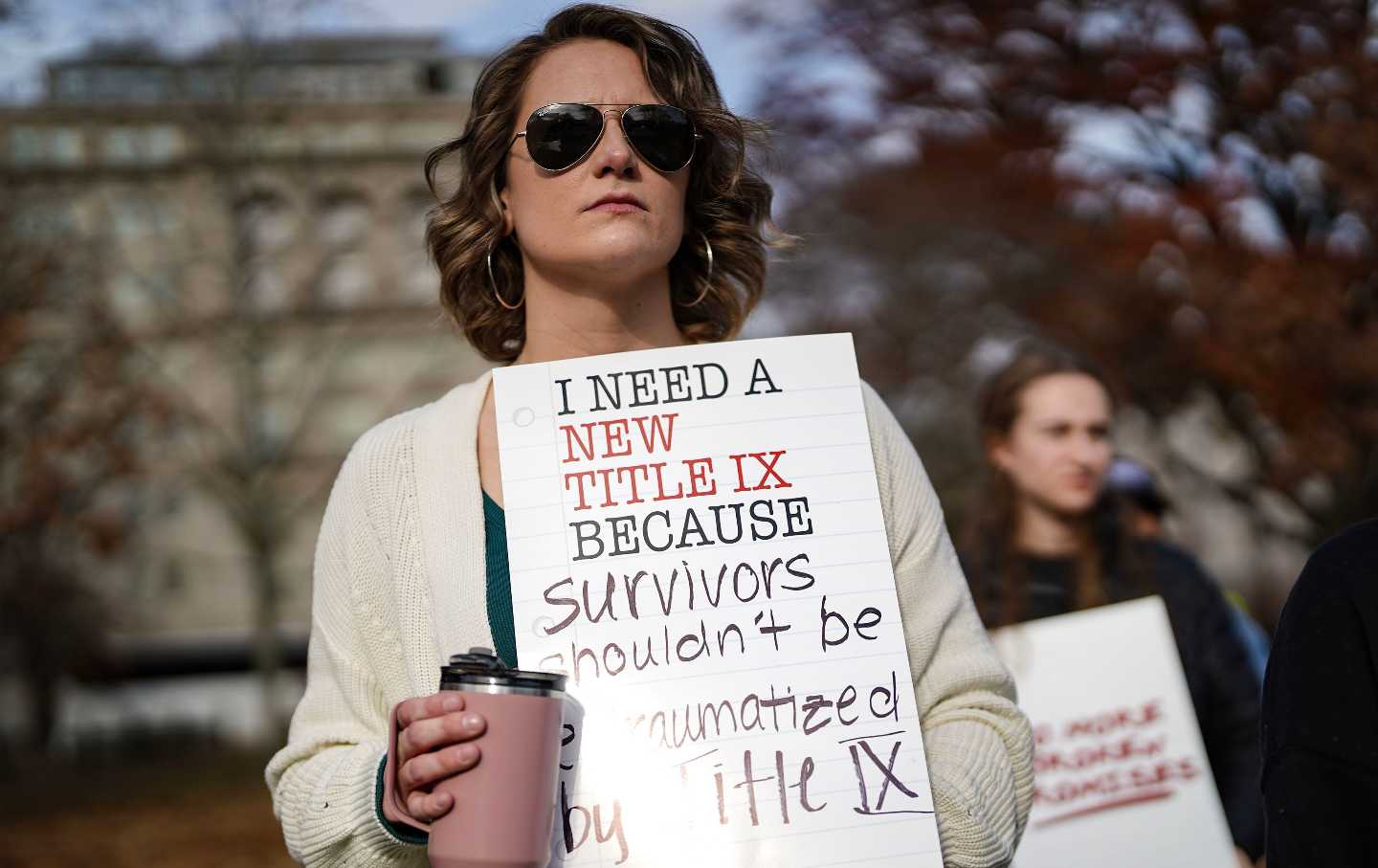Beer Halls and Brownshirts
The first time the Nazis tried to seize power.
The First Time the Nazis Tried to Take Power
The year that broke Germany.

Nuremberg, 1923.
(Heinrich Hoffmann / Getty)At 8:45 pm on November 8, 1923, Adolf Hitler, then 34 and the little-known leader of a tiny, violent extremist group called the National Socialist German Workers’ Party, stormed into the crowded main hall of the Bürgerbräukeller, a beer hall in the Bavarian state capital of Munich. Standing on a chair, Hitler fired his gun into the ceiling to gain attention. Then he bounded onto the stage at one end of the room and shouted: “The national revolution has broken out. This hall is occupied by 600 heavily armed men. No one is allowed to leave. If there is not immediate silence, I will have a Gatling gun set up in the gallery. The Bavarian government is hereby dismissed. The national government is dismissed. A provisional national government will be formed.” Outside, a large contingent of brown-shirted storm troopers surrounded the building, manning a Gatling gun mounted at the entrance to prevent people from entering or leaving. The Beer Hall Putsch had begun.
Hitler did not initially want to launch the putsch that evening. He had planned it for November 11, the fifth anniversary of the armistice that ended World War I—a day of abject shame and surrender for Germany in the eyes of the ultra-right. But Hitler moved the date forward when he learned that another group of prominent figures in right-wing Bavarian politics—Gustav Ritter von Kahr, Hans Ritter von Seisser, and Otto von Lossow—planned to hold a public meeting in the Bürgerbräukeller on November 8, at which point they were going to announce their own coup aimed at toppling the government in Berlin.
Books in review
-
1923: The Crisis of German Democracy in the Year of Hitler’s Putsch
Buy this book -
Germany 1923: Hyperinflation, Hitler’s Putsch, and Democracy in Crisis
Buy this book
All three had come to power in the chaotic period after the overthrow of the Bavarian monarchy in 1918, which had been followed by a revolutionary regime led by the Communists. After the revolutionaries were violently suppressed by paramilitaries hired by the elected Bavarian government, these men had established the southern German state as a center of opposition to the national political system created by the country’s new democratic Constitution of 1919, the so-called Weimar Republic. Hitler’s intervention in the beer hall was aimed at preempting their rebellion, and after his announcement, he arrested them and forced them to declare that they accepted his leadership.
But even if Hitler had successfully trumped his right-wing rivals, his attempted coup soon began to go seriously wrong. His most prominent backer was the retired general Erich Ludendorff, the virtual dictator of Germany during the latter stages of World War I. Ludendorff accepted the patently insincere pledges of support from Kahr, Seisser, and Lossow and had them released, while Hitler left the beer hall to supervise events elsewhere. But as soon as they were free, the trio withdrew their backing from Hitler and declared their promises null and void. They assured the public that the army and the police remained under their direct control. Meanwhile, Hitler’s storm troopers arrested the city’s socialist mayor and held him hostage, along with several prominent local Jews, reflecting his belief that the overthrow of the monarchy and the creation of the Weimar Republic had been the work of Jews and socialists steering events from behind the scenes—a paranoid conspiracy theory that was eventually used to launch the Holocaust.
Things got even worse for Hitler and his co-conspirators after this. The following morning, as the reality of their mistakes began to dawn on them, they tried to save the situation by marching into the city center, where they hoped to rouse the population behind them. Crowds of supporters cheered them as they as they advanced through the streets. But before they reached the large central square of the Odeonsplatz, a contingent of armed police met them in front of the 19th-century military monument known as the Feldherrnhalle. Scuffles broke out, a shot was fired, and for some 30 seconds a gun battle raged, leaving 14 putschists and four policemen dead. Hitler was pushed to the ground, dislocating his shoulder. Fleeing the scene, he got medical treatment from a supporter and then was arrested a few days later. Soon afterward, the Nazi Party was banned and its offices shut down.
The putsch was thus an abject failure. Hitler had acted prematurely and without proper preparation. He had neglected to secure the support of the army and police, the civil service and the business community. His own forces were numerically inadequate and ill-equipped. As Kahr wrote in his report on the failed coup: “It was surprising that Hitler made hardly any serious attempts that night to gain control over important public buildings like the telegraph and telephone centers, government offices or the main train station.”
As preparations were made for the trial of the putsch leaders, Hitler fell into a brief period of suicidal despair. But he soon realized that he could make political capital out of the proceedings. Held before a sympathetic nationalist judge, who allowed him to deliver lengthy and impassioned speeches from the dock, the trial was extensively covered in the national press and projected Hitler onto the national scene. He was given an extraordinarily mild sentence: “fortress confinement” in the modern state prison at Landsberg, not far from Munich, where the conditions were so lenient that Hitler was able to write most of Mein Kampf and live very comfortably thanks to numerous presents and donations from well-wishers. Recently unearthed prison files have revealed that during the few months he spent there, Hitler received no fewer than 345 visitors to his large and well-appointed quarters on a total of 524 occasions. By the time of his release, Hitler had come to an important realization: that power could be won only with the mass support that had been lacking in 1923—but in addition to this, it had to be accompanied by mass violence and intimidation on the streets, to beat down the Communists and Social Democrats who were the Nazis’ principal opponents. It also required the backing of the mainstream right-wing political establishment in Germany. By 1933, Hitler had brought into being all of these elements and succeeded where a decade earlier he had failed.
Why did Hitler pick 1923 as the moment to strike? This is the question that two excellent new books—Mark William Jones’s 1923: The Crisis of German Democracy in the Year of Hitler’s Putsch and Volker Ullrich’s Germany 1923: Hyperinflation, Hitler’s Putsch, and Democracy in Crisis—have chosen to address. The two books cover almost exactly the same ground, and both are well researched and clearly written, recounting the putsch and the events leading up to it with authority and verve.
The differences between the two books stem partly from the contrast between their authors, who come from different countries and different generations. Ullrich, who’s in his early 80s, is an experienced, academically qualified but freelance German historian and journalist with a score or more books to his name, including a recent, authoritative two-volume biography of Hitler. He writes in enviably engaging and flowing prose (ably translated here by Jefferson Chase) and makes excellent use of a rich range of diaries and memoirs covering the events. Mark William Jones, an Irish scholar in his forties, teaches at University College, Dublin. He has only one previous book to his name, on the German Revolution of 1918–19, but he has developed an ability—all too rare among academics nowadays—to communicate easily with a wider, nonacademic readership. His book has deservedly won the equally rare accolade of being translated into German.
Both books show convincingly that Hitler’s Beer Hall Putsch was an attempt to take advantage of the chaotic and, in many respects, desperate condition of Germany in 1923. The peace settlement of 1919 had imposed a hefty bill of “reparations” to France and Belgium as compensation for the years of damage caused by the battles fought there since August 1914 and the German military occupation that followed. The settlement also reflected the Allied claim that Germany had deliberately started the war, a claim that almost all Germans vehemently rejected. Since it would have been political suicide for any German government to fund such reparations by raising taxes, the country soon began to fall behind on its payments, with the result that France sent in troops to Germany’s main center of industry, the Ruhr Valley, to collect them in kind in the form of coal and mining products.
The German government then mounted a campaign of “passive resistance,” which was supported by the majority of Germans. Far-right activists went further and engaged in violent resistance to the French seizures. There were numerous arrests, including of a former officer, Albert Leo Schlageter, who blew up a railway line carrying coal and iron into France. He was arrested by the French, tried for sabotage, and shot by a firing squad. Perhaps reflecting the fact that he belongs to the “Me Too” generation, Jones focuses far more sharply than Ullrich on incidents of French troops raping and sexually abusing German women during the occupation; on the other hand, he doesn’t pay sufficient attention to the widespread racist outrage in Germany at the fact that the French had brought in Black colonial troops, to whom many of these assaults were falsely attributed.
The peace settlement had put the Rhineland, centered on Cologne, under Allied occupation until 1930, and this allowed the French to encourage a separatist movement that aimed to create a breakaway Rhenish state. Both authors pay considerable attention to this movement—not least because of the involvement of Konrad Adenauer, who was then mayor of Cologne and would become the first chancellor of the Federal Republic of Germany after the World War II—but in truth, the movement never had much support and should not be taken too seriously.
More threatening was the emergence of far-left coalition governments in the central German states of Saxony and Thuringia, based on a collaboration between Communists and left-wing Social Democrats, which prompted the mainstream Social Democratic Reich President Friedrich Ebert to intervene. In October 1923, he suspended the two state governments and used the army and paramilitaries to impose order, which resulted in a number of shootings of protesters. The hope that these events would trigger a new revolution in Germany (a “German October”) was dashed, and the Communist Party’s armed units were forcibly disbanded. Only in the northern city of Hamburg did the Communists find themselves able to stage an armed uprising, and this, too, was quickly suppressed.
As both Jones and Ullrich argue, these events prompted both Hitler and Kahr to conclude that the Weimar Republic was in the throes of dissolution and could be overthrown. Bavaria seemed like the perfect place to begin. Underpinning all this was an unprecedented economic crisis triggered above all by the collapse of industrial production in the Ruhr. The exchange rate of the German mark against the US dollar, already falling sharply because the country was printing money without being willing or able to back it properly, had plummeted by the autumn of 1923. In August 1922, it took 1,000 marks to buy a dollar; by August 1923, 4 million; in October, 25.3 billion; and by December, 4.2 trillion. So rapid was this hyperinflation that you might sit down for a cup of coffee in a restaurant and find that it had doubled in price by the time you got up to pay the check. Emergency banknotes were printed in denominations of a billion or more. Employees collected their weekly wages in wheelbarrows and rushed to the shops to buy supplies before they were no longer able to afford them. The economy more or less ground to a halt.
Popular
“swipe left below to view more authors”Swipe →But the economy managed to recover; passive resistance was called off by a new national government; the reparations payments were renegotiated; and a series of financial reforms led to a new currency, the rentenmark, backed by a version of the gold standard. With Hitler in jail, the Communists abandoning the idea of a violent revolution, the French withdrawing from the Ruhr, and the situation in Bavaria calming down, the Weimar Republic was able to steer itself into calmer waters.
It was only with the total paralysis of the economic system caused by the Great Depression, starting in 1929, that the political system really began to break down. The parties in the coalition government were unable to agree on measures to restore the economy, and the government of the day had to rule by decree. It was then that Reich President Paul von Hindenburg, a conservative who had led the German Army during the war alongside the now-discredited Ludendorff, decided to break the political and economic deadlock by getting rid of the cumbersome machinery of parliamentary democracy. But he needed the mass support that only the Nazis, who now had the backing of a good third of the electorate, were able to supply. On January 30, 1933, Hindenburg appointed Hitler as the head of a new coalition government. Assuring the army that he would embark on a massive program of rearmament, and winning over the conservative nationalist majority in the coalition by a mixture of bullying and violence, Hitler swiftly dismantled Weimar democracy and created a one-party dictatorship.
Meanwhile, he turned the events of 1923 into a legend, pushing the abject failure of his attempted coup into the margins of memory and propagating the growing Nazi cult of sacrifice. The “blood flag” that was carried by the marchers in Munich after the Beer Hall Putsch and stained with the blood of those shot by police was solemnly paraded at the Nazis’ rallies in Nuremberg every year. Nor did Hitler fail to take revenge on those he felt had betrayed him: Seisser was arrested and spent the whole of the Third Reich in Dachau, the first Nazi concentration camp, while Kahr was taken to the same camp on the Night of the Long Knives on June 30, 1934, badly beaten, and then shot. Not wanting to offend the army, Hitler left Lossow alone but made sure he never held another position of command.
Both Jones and Ullrich recount this story well, although I wish they had devoted less attention to the minutiae of the political maneuverings involved in the formation and breakup of the numerous interwar governments, which frequently become a bit tedious. To compensate for this, Ullrich does provide a compelling account of the development of “Weimar culture,” describing the films, drama, literature, and visual arts of this period (though, unaccountably, he has next to nothing to say about its music). But neither historian makes much of an attempt to lay out the lessons that might be learned today from the failure of Hitler’s early insurrection.
Comparing the Beer Hall Putsch with the events of January 6, 2021, in Washington, D.C., it is striking that in neither case was there a carefully prepared effort to seize power; nor did the instigators manage to secure the backing of the military and police, as crucial as this is if you are trying to take over the government of a country by force. Nevertheless, it is the contrasts that stand out. In place of the uniformed brownshirts of 1923, January 6 witnessed a motley and disorganized mob of often bizarrely dressed individuals, many of them carrying banners more in the manner of a demonstration than a coup. The institutions of the United States are far more robust and deeply rooted in the national political culture than were those of the Weimar Republic. Nevertheless, the danger of another violent assault on democracy and the US Constitution taking place in 2024 remains, especially with Donald J. Trump as the likely presidential candidate of the Republican Party.
Thank you for reading The Nation!
We hope you enjoyed the story you just read. It’s just one of many examples of incisive, deeply-reported journalism we publish—journalism that shifts the needle on important issues, uncovers malfeasance and corruption, and uplifts voices and perspectives that often go unheard in mainstream media. For nearly 160 years, The Nation has spoken truth to power and shone a light on issues that would otherwise be swept under the rug.
In a critical election year as well as a time of media austerity, independent journalism needs your continued support. The best way to do this is with a recurring donation. This month, we are asking readers like you who value truth and democracy to step up and support The Nation with a monthly contribution. We call these monthly donors Sustainers, a small but mighty group of supporters who ensure our team of writers, editors, and fact-checkers have the resources they need to report on breaking news, investigative feature stories that often take weeks or months to report, and much more.
There’s a lot to talk about in the coming months, from the presidential election and Supreme Court battles to the fight for bodily autonomy. We’ll cover all these issues and more, but this is only made possible with support from sustaining donors. Donate today—any amount you can spare each month is appreciated, even just the price of a cup of coffee.
The Nation does not bow to the interests of a corporate owner or advertisers—we answer only to readers like you who make our work possible. Set up a recurring donation today and ensure we can continue to hold the powerful accountable.
Thank you for your generosity.
More from The Nation

The Covid Revisionists Are Endangering Us All The Covid Revisionists Are Endangering Us All
As the possibility of a new pandemic looms, influential figures are telling us we shouldn't have been so worried about the last one. This spells trouble.

How New Title IX Rules Leave Sexual Assault Survivors in the Lurch How New Title IX Rules Leave Sexual Assault Survivors in the Lurch
The Biden administration’s updates to the regulations have laudable aims, but one blind spot leaves victims vulnerable to retaliatory lawsuits.

On Sex Ed, “Our Side” Is Finally Fighting Back On Sex Ed, “Our Side” Is Finally Fighting Back
The new group EducateUS is creating a counter-movement to the conservative groups stoking a culture war over sexuality education.

This Supreme Court Case Could Worsen Maternal Health Nationwide This Supreme Court Case Could Worsen Maternal Health Nationwide
The state of Idaho wants the court to ban abortions permitted under the Civil Rights–era Emergency Medical Treatment and Active Labor Act.

The Use of “Attention Capture” Technologies in Our Classrooms Has Created a Crisis The Use of “Attention Capture” Technologies in Our Classrooms Has Created a Crisis
We have a choice: We can allow Big Tech to solve the problem with invasive brain technology. Or we can let educators teach students how to pay attention.

What the Cass Review Means for Trans Kids in Britain—and Beyond What the Cass Review Means for Trans Kids in Britain—and Beyond
A new review of gender-affirming healthcare in England could change the way gender-questioning children and young everywhere people receive care.


